Growing your own peppers is easy, and doesn’t require much work. Whether you put your plants in pots or in your garden, the basic care is the same.
In this detailed guide, I’ll give you all the information you need to be successful. You’ll learn everything from planting, location, sunlight, water, fertilizer, pest control, and pruning, all the way through harvesting.
Every time I share a photo of my bounty on social media, people always ask “How do you grow such big, beautiful peppers?“.
Over the years I have learned lots of tricks for consistently producing an amazing crop in my garden. So below, I’m going to share my best tips with you.
Quick Pepper Plant Care Overview
| Scientific name: | Capsicum |
| Classification: | Vegetable |
| Common names: | Peppers |
| Hardiness: | Zones 10+ |
| Temperature: | 60-85°F |
| Flowers: | White, blooms repeatedly |
| Light: | Full sun |
| Water: | Allow soil to dry between waterings, do not overwater |
| Humidity: | Average |
| Fertilizer: | High phosphorus fertilizer spring-summer |
| Soil: | Rich, fertile, well-draining |
| Common pests: | Aphids, mealybugs, whiteflies, spider mites, hornworms |
Information About Pepper Plants
Pepper plants (capsicum) are wonderful, and so versatile. This popular veggie is a member of the nightshade (Solanaceae) family, along with tomatoes, eggplants, tomatillos, and potatoes.
You might be surprised to learn that capsicum plants are perennials native to the tropical regions of North and South America, where some varieties can live for many years, and grow to be large shrubs.
Different Types Of Pepper Plants
There are hundreds of different kinds of peppers, so you can have fun growing new types every year. They come in a wide variety of shapes, sizes, colors, and flavors.
Some can mature to be several feet tall, while others stay much smaller, and more compact. The size, color, and shape of the fruits also vary greatly.
You can find peppers in just about any color, from white to yellow, orange, red, green, purple, to almost black. Some are even variegated!
The flavors vary almost as greatly as their colors. You’ll find they range anywhere from mild, to sweet, slightly spicy, or hot, all the way up to OMG-my-mouth-is-on-fire (that’s not a technical term, haha).
Here are some of my favorite varieties to plant in my garden every year…
- Bell (sweet)
- Sweet banana (sweet)
- Purple bell (mild)
- Poblano/Ancho (mild)
- Padron chile (mild to hot as they mature)
- Chilli (medium)
- Cayenne (hot)
- Fish variegated (hot)
- Jalapeno (hot)
- Ghost (super hot)
- Habanero (super hot)
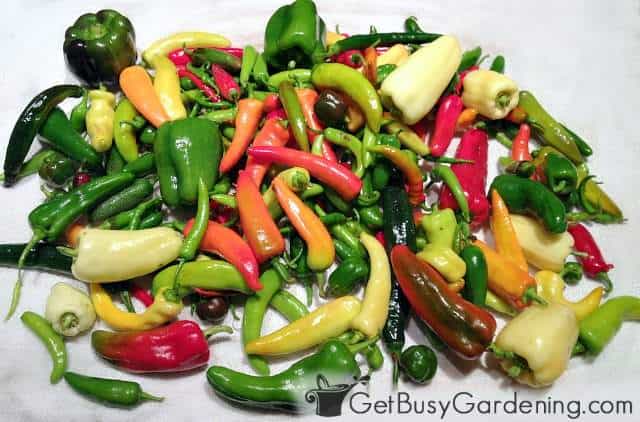
Hardiness Of Peppers
Though most gardeners grow peppers as annuals they replant every year, they’re actually tender perennial plants that can live for many years in the right climate.
So, if you live in a warm enough area (zone 10b or above), you can grow them in your garden year round.
In colder climates, you must either start over with new plants every year, or you could overwinter your peppers indoors. That way, you can keep your favorite varieties year after year.
How Do Peppers Grow?
Capsicum plants must flower to produce fruit. Shortly after the flowers have been pollinated, tiny baby peppers will start growing out of them.
If the flowers die and fall off, that means they weren’t pollinated. But it’s easy to hand-pollinate them by simply taking your finger and touching the inside of each flower, one after another.

Where To Grow Pepper Plants
One of the things I love the most about growing peppers is that they perform equally well in containers as they do in the ground. Heck, you could even bring them inside, and keep your favorite varieties for many years.
Indoors
If you want to try growing peppers indoors, choose a warm room where they will get a lot of sunlight. A south facing window is the best spot for them.
They will get leggy indoors without the proper amount of light. If that starts happening, add a grow light, and set it on a timer so it stays on for 12-14 hours a day.
You certainly could keep them indoors all year, but you’ll probably find it’s easier to move them outside for the summer.
For best results, wait to move them outdoors until it’s consistently above 55°F, and be sure to slowly acclimate them to the sun or their leaves will get sunburn.
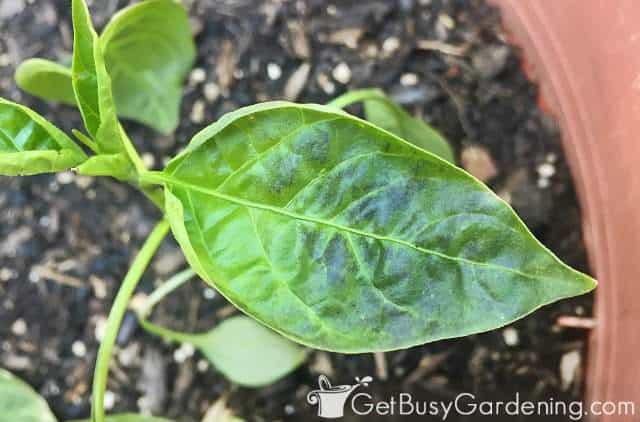
Outdoors
Outdoors, plant your peppers in a sunny location that has fertile, fast draining soil. They won’t tolerate wet roots, so make sure the area you choose has good drainage.
If the soil in your garden is too wet, you can amend it with coarse sand, pumice or perlite to help it drain faster.
Peppers also do very well in containers, so they’re an excellent choice for growing on a sunny patio, deck, or balcony.
Planting Tips
Before getting into the detailed care instructions, it’s important to understand a few key things about when and how to plant your peppers.
When To Plant
It’s safe to plant your peppers outside once the soil has warmed up in the spring, nighttime temps are consistently above 50°F, and all chance of frost is gone.
It’s not beneficial to try planting them early. Cool temperatures will stunt their growth, and they will not tolerate frost at all.
How To Plant
Whether you have your own seedlings, or starts from the garden center, it’s good to plant them 1-2″ deeper than they were growing in the pot.
They will form new roots along the stem that’s underground, making the plant much stronger. Remove a few sets of the bottom leaves before planting, if necessary.
Pepper plants don’t need a ton of room, which is great for those of us with small garden plots. But don’t overcrowd them. Space them 18-24″ apart, depending on the size of the mature plant.
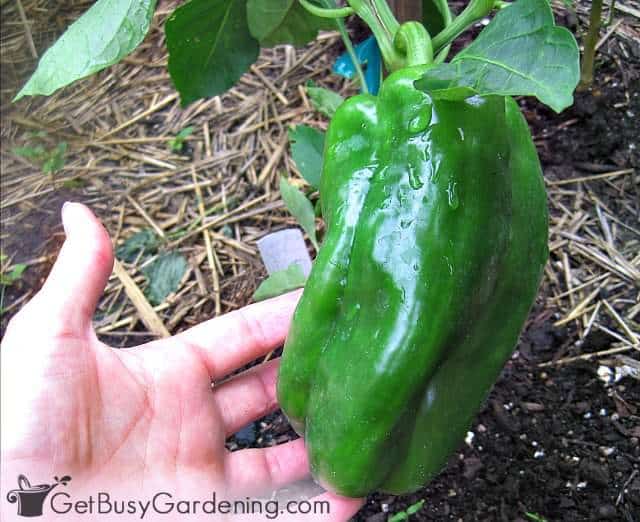
Pepper Plant Care & Growing Instructions
Below you’ll find my complete care instructions, based on decades of experience with growing my own peppers. If you follow my tips, you’re sure to get the largest and best harvest you’ve ever had – no matter which variety you want to grow.
Water
Whether you grow your peppers in pots or the garden, they will not tolerate having wet feet for very long.
So it’s very important to keep the soil on the dry side. Allow it to dry between deep waterings, but never to the point where the plant starts drooping.
It’s also crucial to give them an even and consistent amount of moisture. Inconsistent watering can stunt their growth, slow down fruit production, and is a contributing factor for blossom end rot.
If you struggle with giving your plants the right amount of water, then use a moisture meter to make it easy to get just right.

Sunlight
Pepper plants need full sun to grow and produce flowers and fruits, and the more sunlight the better. Though they will tolerate partial shade, you will get a much smaller yield.
Ideally, they should get at least 8 hours of direct sunshine every day. But they will still perform with as little as 6, as long as they’re in full sun during the peak hours of the day.
If your yard is pretty shady, then choose a spot where they’ll be in the sun during the afternoon when the rays are the most intense.
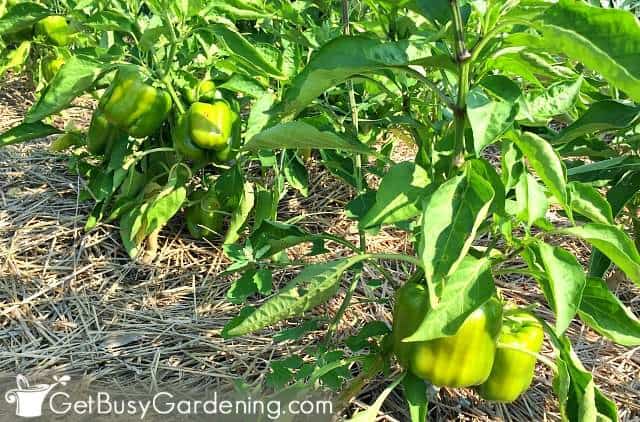
Soil Requirements
The best soil for pepper plants is one that is rich in organic nutrients, and also fast draining. They don’t like soggy soil, and too much water can cause issues like mildew and rotting, or even stunt their growth.
Use a quick-draining mix for containers, or amend poor quality garden soil with compost or worm castings, and coarse sand to improve drainage.
Though they will tolerate acidic conditions, they perform best in alkaline soil. If the leaves are turning yellow, or your plants aren’t growing, it’s a sure sign that the soil is too acidic.
A soil probe or home test kit are quick ways to test the pH. If you find that your soil is acidic, then adding garden lime is an easy fix to neutralize it.
Fertilizer
Regular fertilizing will help your plant grow faster, and encourage it to produce bigger peppers. A rich, organic plant food is the best type to use.
Add slow-release granules to the soil at planting time, and then again once or twice during the summer. It’s also good to feed them every few weeks using a liquid fertilizer, like fish emulsion or compost tea.
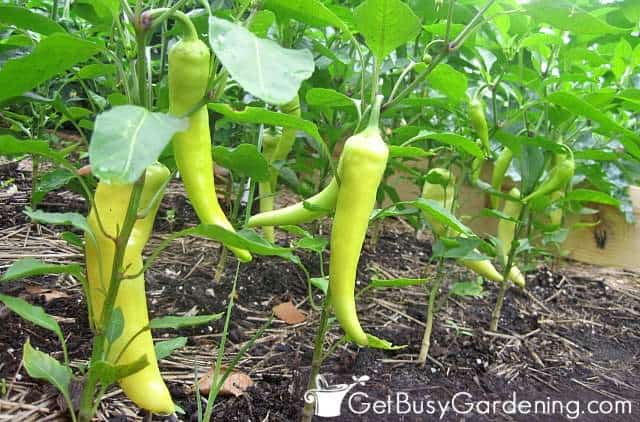
Pest Control
As far as insects go, pepper plants are aphid magnets, which is usually more of a problem indoors than it is outside. Other common pests include mealybugs, whiteflies, spider mites, and hornworms.
If you find a bug infestation, wash the leaves with organic insecticidal soap, or make your own spray by mixing one teaspoon of mild liquid soap with one liter of water. Neem oil also works great.
Disease Control
Diseases like powdery mildew and bacterial leaf spot can sometimes become a problem. Blossom end rot is also very common, and happens when there is a calcium deficiency caused by inconsistent watering.
You can easily prevent disease and mildew issues with proper plant spacing and consistent watering. An organic fungicide can help to control mildew and fungus problems in their early stages.
Pruning
You don’t need to prune your peppers very often, they usually stay fairly compact on their own. But they will grow bigger fruits if you pinch off some of the flower buds once the plant starts producing.
They will also produce more when you regularly pinch the suckers. This is the extra growth between the leaf and stem joints, or around the base of the plant.
Related Post: How To Can Peppers
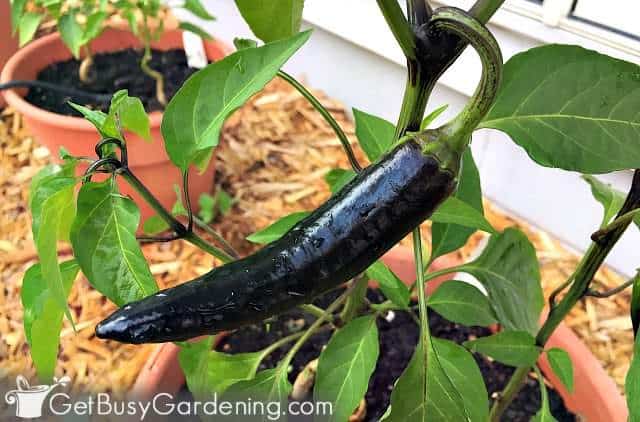
Tips For Harvesting Peppers
One of the things that makes growing peppers so easy is that you can harvest them at any time. You don’t even need to wait for them to ripen.
However, the longer you leave them on the plant, the hotter (or sweeter) and more colorful they will become. The exact amount of time it takes for them to ripen depends on the variety.
Once they’re ready, use a sharp pair of pruners to cut them, rather than pulling them off. Otherwise you could break the branch, or cause other damage to the plant.
Related Post: How To Preserve & Store Peppers Long Term
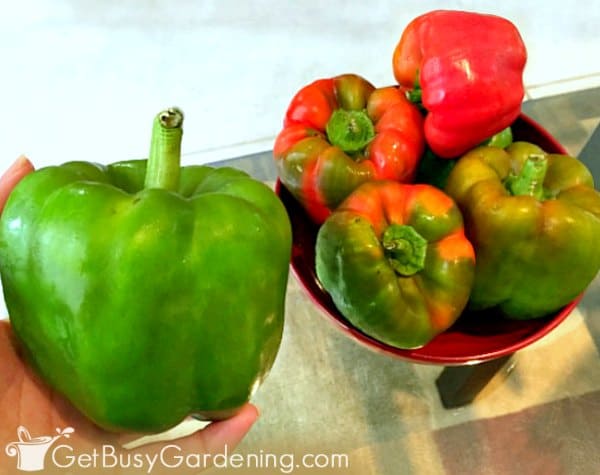
Propagating Pepper Plants
You can propagate your pepper plants by either rooting the stem cuttings or saving the seeds. Take 3-4″ long stem cuttings during the summer.
Remove the bottom leaves, then stick them in the soil. Keep the soil moist, and the air humid. After a few weeks, the cuttings will form new roots. You can learn exactly how to start your peppers from seed here.
Troubleshooting Common Problems
The hardest thing about pepper plant care is when they start having issues, and you have no idea why. So below I will list some of the most common problems you might run into, and give you tips for how to fix them.
Pepper Plants Are Slow Or Not Growing
If the plant doesn’t seem to be getting any bigger, it’s usually caused by improper watering, extreme temperatures, or too much shade.
Make sure you have them in a warm, full sun location, and that you’re giving your plant consistent and even waterings. Also, some varieties don’t grow very large, so it may just have reached its mature size.
Flowers Falling Off
When the flowers die and fall off without producing any fruits, that means they weren’t pollinated. If the bees aren’t helping, then you can pollinate the flowers yourself by gently rubbing the inside of each one with your finger.
Leaves Turning Yellow
Yellow leaves are usually caused by overwatering, but it could be from overly acidic soil, or a nutrient deficiency.
Use a pH probe to monitor the acidity, and check the soil to see if it’s too wet or dry. If it’s neither of those, then you could try feeding your plant.
Rot On The Bottom Of The Fruits
When the fruits start to rot from the bottom up, it is called blossom end rot. This is a very common problem, especially for containerized peppers.
It happens when the plant can’t get enough calcium because of improper watering, and is easily fixed by providing consistent moisture. The soil should never be bone dry.
Related Post: How To Dry Cayenne Peppers In 4 Easy Ways
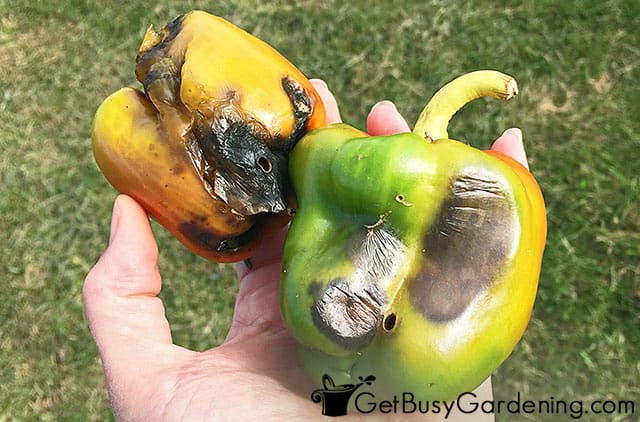
FAQs About Growing Peppers
In this section, I’m going to address some of the most frequently asked questions about caring for pepper plants. If you can’t find your answer here, then ask it in the comments below.
Related Post: How To Make Crushed Red Pepper Flakes
How long does it take to grow a pepper?
Pepper plants need a fairly long growing season to produce mature fruit. Depending on the variety, it can take anywhere from 100-150 days (4-5 months) to grow them from seed to harvest.
What month do you plant peppers?
The exact month depends on where you live. If you’re in a warm climate, you can plant them at any time. However, if you live somewhere cold, then wait until the soil is warm, and all chance of frost is gone in the spring.
How much sun does a pepper plant need?
Capsicum plants need 8+ hours of full sun outdoors, and 12-14 hours of bright light indoors (either from a south-facing window, or by using grow lights).
Do pepper plants grow back every year?
Pepper plants are evergreen perennials in zones 10b or higher, and they can grow back every year in some lower zones. However, they will die if it gets below freezing, so you’ll need to replant them annually if you live in a cold climate.
Do pepper plants need a lot of water?
Pepper plants do not need a lot of water, and will start to suffer if it’s too wet. But they do need consistent moisture. The soil should dry out slightly between waterings, but never to the point where the plant starts to droop.
Growing peppers is easy when you know the secrets to success. And now that you know exactly how to do it, you’ll have your best crop ever.
If you’d like to learn how to make the most of your space and get as much homegrown food as possible, then my Vertical Vegetables book is perfect! It will teach you all you need to know, has tons of gorgeous photos, and includes 23 DIY projects you can build for your own garden. Order your copy today!
Learn more about my Vertical Vegetables book here.
Share your tips for growing peppers in the comments section below.
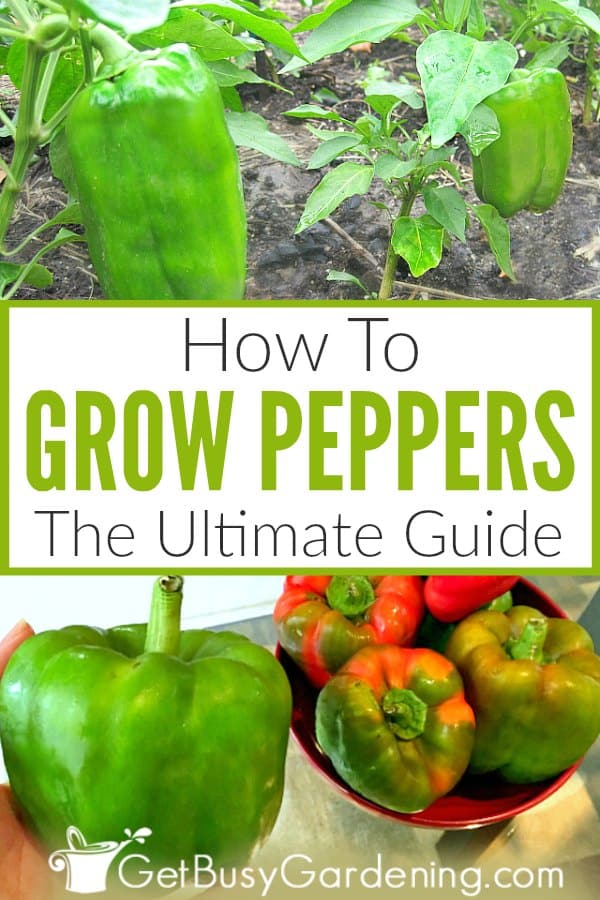

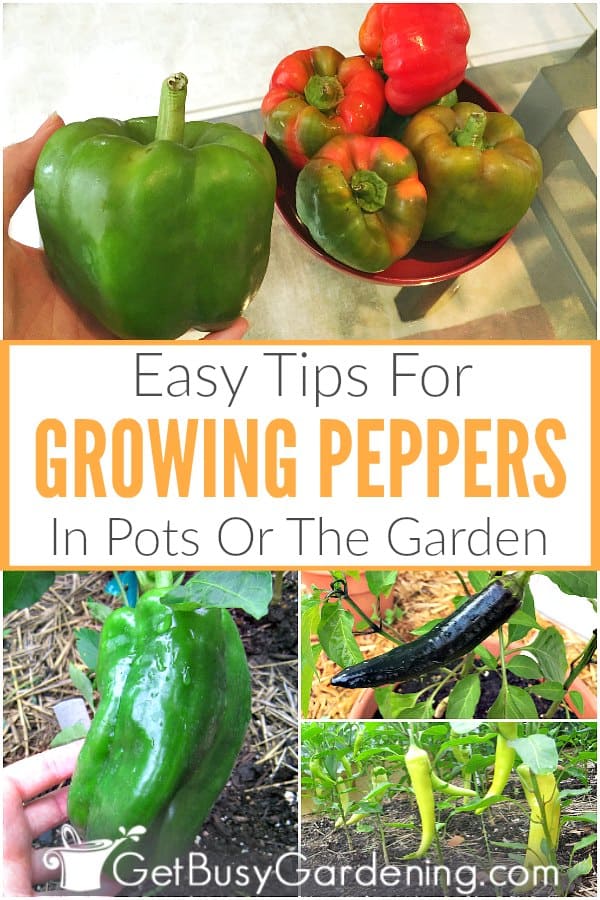

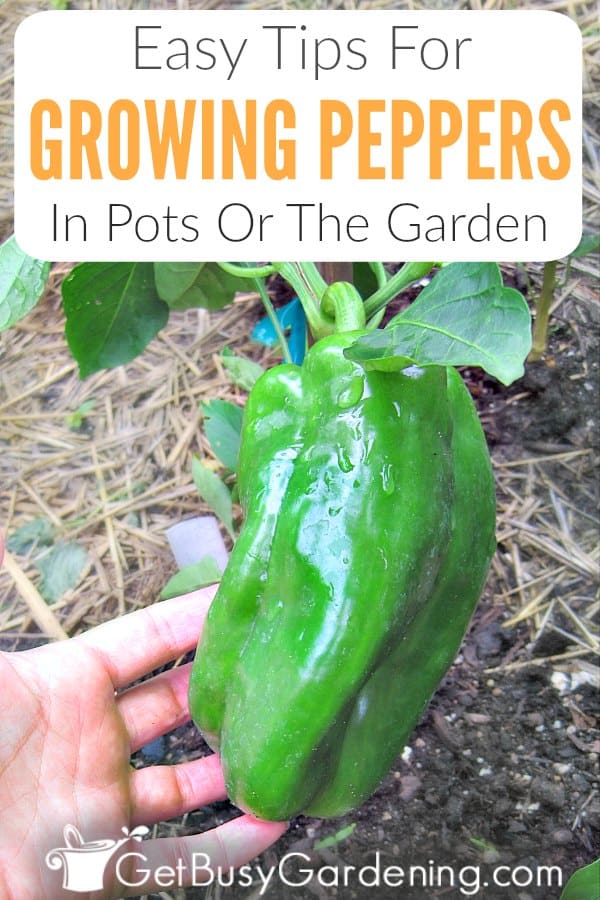

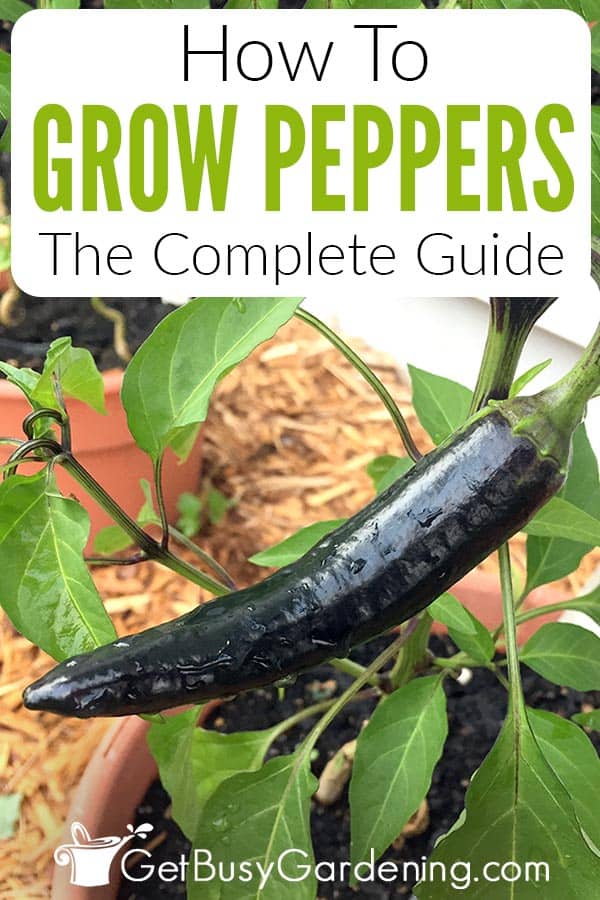
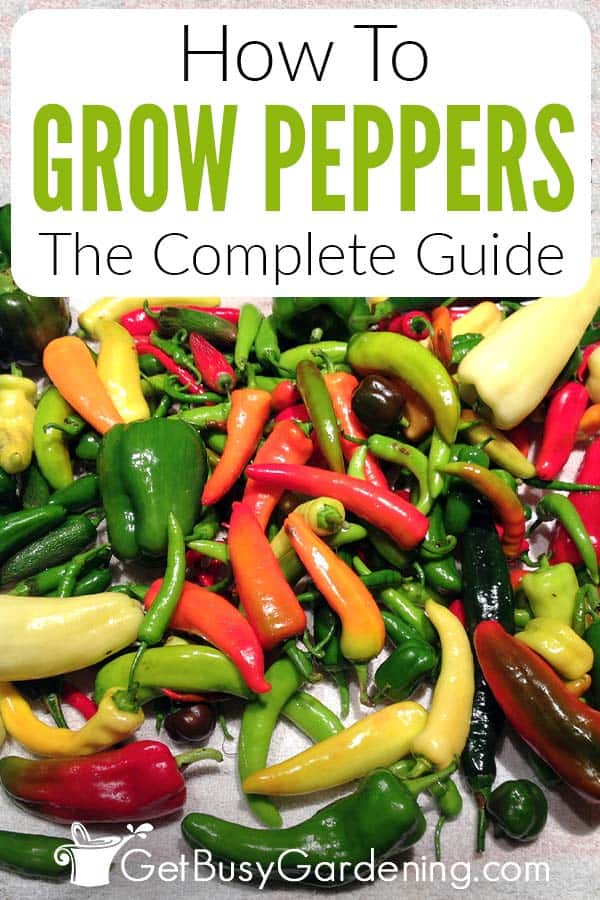
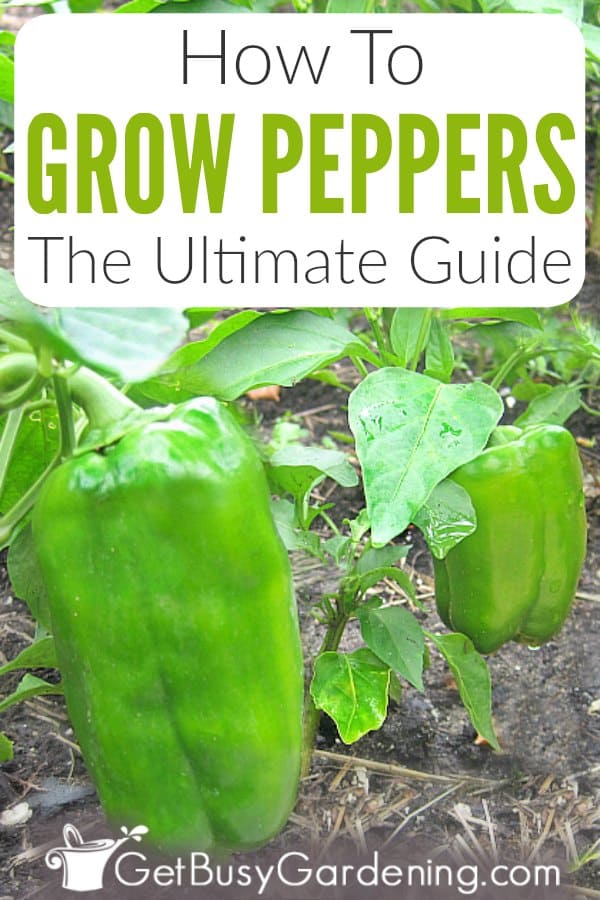
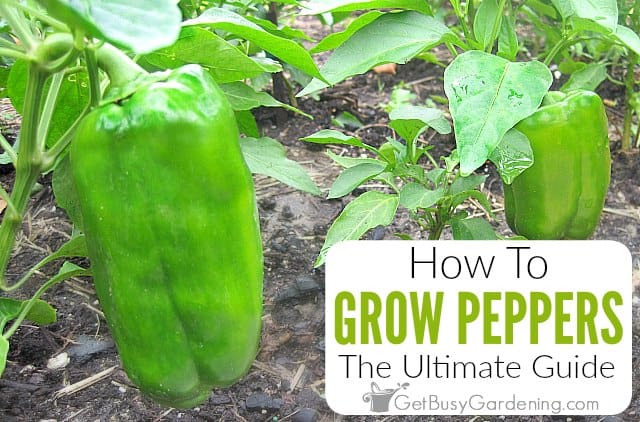



Dave says
Why is it my bell pepper plants take all summer and grow to about 3’ tall before bearing about 4-5 peppers, yet I see other folks plants at 18” tall loaded down with peppers? I even decreased the nitrogen last year, gave it tiger bloom at blossom time and I believe I gave it some Neptune’s harvest fish fertilizer. The initial soil (pro mix 50/50) was amended es with azomite (reapplied monthly), a little granular lime, and granular 10-10-10. And they get at least 8 hours sun. Other than looking like a Caribbean island, I just don’t see the abundance out of them. Is it a variety thing or am I doing something wrong. I don’t use compost because I don’t want the 5 gallon buckets to heavy. I try to make up for that with nutrients. It saves my back, lest I end up in bed for days at a time.
Amy Andrychowicz says
I would definitely recommend using a fertilizer where the middle number is highest (so that means it’s high in phosphorous). When you said that your plants look like a Caribbean island, that makes me think that they have tons of lush green leaves, but are lacking in fruit. That tells me that they are getting too much nitrogen (which promotes lush green leaves), but not enough phosphorous to promote flowering. The more flowers pepper plants get, the more fruit they will produce. However, if they have tons of flowers, but not a lot of peppers, then that means they aren’t being pollinated. If that’s the case, you can pollinate them yourself by gently rubbing your finger in each of the flowers, one after another. And take steps to attract more bees to your veggie pots. Here’s more information about fertilizing veggies, which might help you out.
Amy L says
I wonder if you think my green pepper plants have a chance to mature. I planted them from seeds from the grocery store (baby bell peppers) and they started out fine and blossomed as well. The plants continue to blossom, but never set fruit. These plants are in large containers on my patio. They look healthy otherwise and was wondering if they will ever set fruit. Thank you!
Amy Andrychowicz says
When a pepper plants flower but doesn’t set fruit, that means they’re not being pollinated. You can pollinate them yourself by simply gently rubbing your finger on the inside of each flower, and going from flower to flower. Do that every day, or a couple times per week, and you should start seeing baby peppers forming in a few weeks.
Next year, think about planting some annuals around your patio that will attract pollinators to do the work for you. Here’s a post that might help… How To Attract Bees To Your Vegetable Garden.
Moe says
My habanero plant (growing in a pot) was growing well and had lots of nice peppers. All of a sudden their leaves have started drooping and falling off. Leaves are green. I only water when the topsoil dries out.
Amy Andrychowicz says
When pepper plants droop and start dropping their leaves, that usually means they aren’t getting enough water. But it could also be a sign of overwatering. The only way to know for sure is to stick your finger at least one inch into the soil to check for moisture. If it’s dry, then you know you’ll need to water it more often.
Lex says
I too am in the Twin Cities. However, this year as been, well, challenging because of the weird weather we’ve been experiencing. I have a jump on many gardeners though, I winter my plants downstairs, I keep them happy with customized plant lighting a watering solution, with the occasional refertillizing.
However, I get medium sized fruits, about 3 ~ 5 inches long and sometimes that wide, too. I’ve never been too good with bell peppers. I would love to know your soil pH, as well as the mineral breakdown. I have a mixture of potting soil, compost, various minerals, (iron, calcium, magnesium, copper, sulpher, and a couple of trace minerals, too). For some reason my peppers crave nitrogen and I can never give them enough. I prefer to use organic minerals, fertillizers, etc. in this regard.
Amy Andrychowicz says
I don’t know the exact mineral breakdown of the soil I use, but it’s a fast draining mix. They aren’t too picky about the exact soil breakdown, as long as it doesn’t hold water for too long. They are however picky about the pH. Peppers need alkaline soil in order to grow their best, so make sure yours isn’t acidic. Also, if your pepper plants have been in the same pots for too long, that may be the problem. They make have used up all the nutrients in the soil, and that’s why it’s hard to give them enough of what they crave. I would repot them into fresh soil in the spring. Then, use a granular fertilize a couple of times during the year, as well as a liquid one each time you water. See the “Fertilizing Pepper Plants” section above for organic fertilizers that I recommend.
lonnie says
I’m growing Carolina Reaper peppers and it seems like they’re awful small they have the tail and they’re ugly and they’re hot but they’re small what can I do to make them grow bigger for next year
Amy Andrychowicz says
Carolina Reaper peppers don’t grow to be very large, only about 1-3″. So, it’s just a smaller pepper. LOL, yes I agree, they are really are ugly looking peppers.